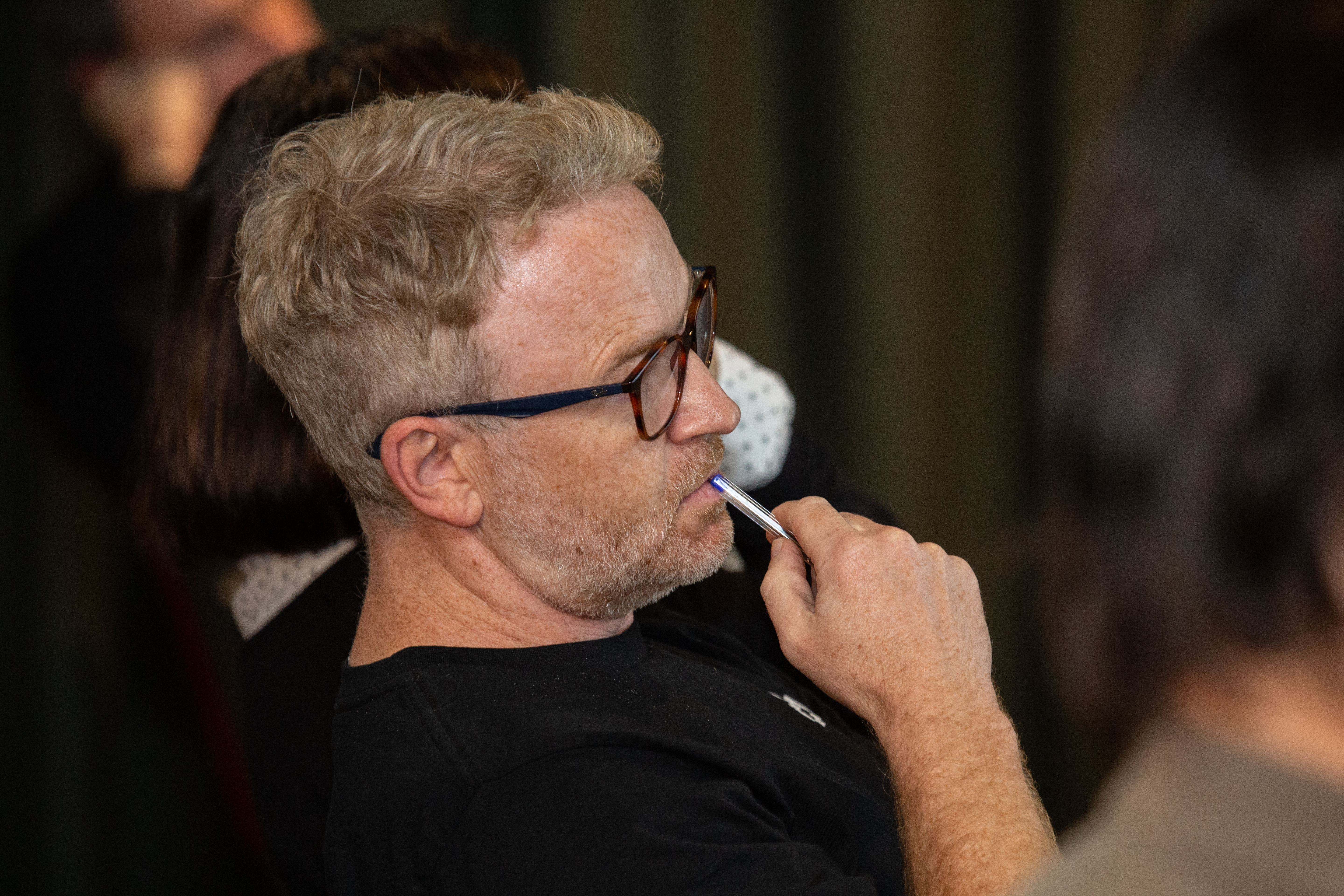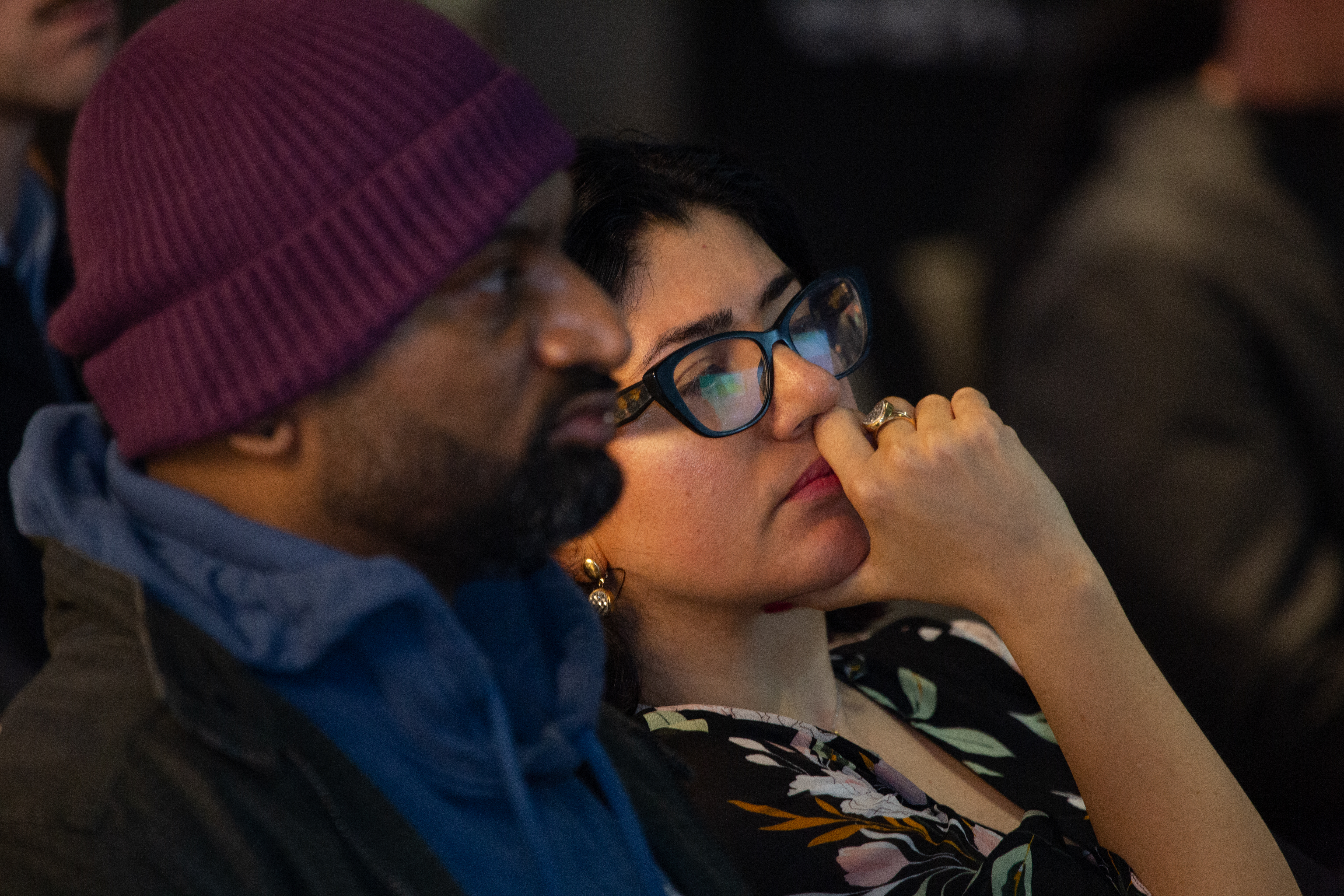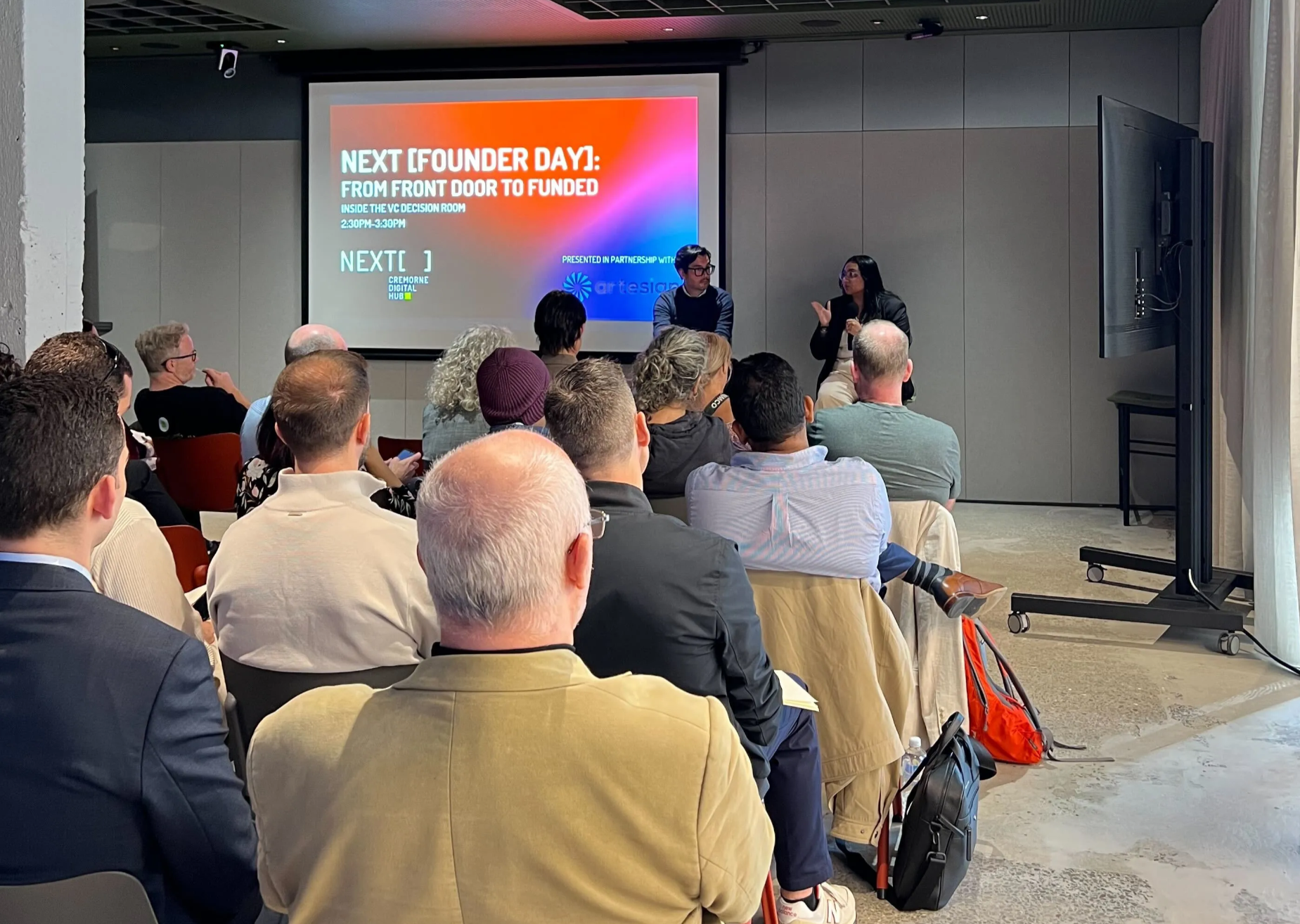This month we hosted our inaugural NEXT[Founder Day] at Cremorne Digital Hub, the first in our high-growth founder event series.
We were lucky to be joined by exceptional speakers including Hugh Stephens (Galileo Ventures), Ananya Sinha (Artesian), and Claire Thompson (Herbert Smith Freehills). Our focus was making the event as information-packed and actionable as possible - covering everything from pitch deck teardowns to term sheet deep-dives.
Thanks to this event’s success, we'll be running a lot more Founder Days throughout the year - Subscribe to our newsletter to be the first to know about upcoming events.
Read on if you're keen to see what got everyone in deep thought:
.jpg)
A caption that describes the image.

A caption that describes the image.

A caption that describes the image.
From Pitch Deck to Foot-in-the-Door
Most founders wish they could be a fly on the wall while VCs are looking through their deck.
Well, at Founder Day we got a rare glimpse into how VCs analyse pitch decks in real-time. Hugh from Galileo Ventures provided candid feedback on three startup decks, offering valuable insights into what makes VCs sit up and take notice.
"The purpose of a deck is to start the process of engaging and working out if you're a fit for us as a fund," Hugh explained.
He emphasised three critical evaluation criteria:
- The Squint Test: "If I squint at this, is it going to get really big? Because VCs need things to get really big." Hugh noted that a profitable 6 million ARR business might be a great success by normal standards but would be "a terrible investment for VC."
- Points of Religion: Every investor has strong beliefs about how the world works or is evolving. When there's a mismatch between a founder's and investor's core beliefs, it's often a non-starter. These things aren’t always objective ‘right’ or ‘wrong’s, but rather opinions that uniquely steer their direction. This means that sometimes your startup might be a great fit for one fund, and a terrible fit for another - on a purely subjective basis.
- The Insight Factor: What makes VCs ask for more? "What leaves us asking for more? What are the areas where I go, 'Oh, I haven't really thought about the market that way' or 'that's an interesting insight'?" It’s important to place your deck in the context of VCs who have seen 100s of decks - they all start to look the same and say the same sorts of messages - how can you stand out?
As Hugh reviewed the decks in real-time, several themes emerged about specific elements:
Market Sizing: Handle with Care
Market sizing slides can be hit or miss. Hugh questioned the value of generic "number is big, number go up" slides without proper context.
Instead of focusing solely on large TAMs and SAMs, founders should articulate:
- How the market is specifically addressable for them
- Why this particular moment is the right time to enter
- How they might expand or create new markets
The best examples (like Stripe and Canva) create a new market - something a TAM slide can rarely capture.
Product Slides: Show, Don't Tell
When it comes to showcasing product, Hugh emphasised quality over quantity. Rather than a bunch of contextless screenshots, or walls of text, consider your strongest hero shots that convey the biggest strengths of your product.
There was a great example where a startup had a features page with four screenshots - but only one caught the eye of Hugh as a key differentiator.
Go-To-Market: Beyond the Checklist
Generic GTM slides received particular skepticism: "I don't really super care about these sort of slides unless it actually has numbers."
That’s because in the early stages, GTM has a load of assumptions, and will always inevitably change.
It’s important to show that you have an idea, of how you’ll go to market - but there’s no need to over-do the projections.
The panel suggested that effective GTM slides should include:
- Actual traction rather than theoretical approaches
- Unique insights about customer acquisition
- Specific data points from early acquisition channels
For one startup’s GTM, Hugh noted "You could cover all of GTM [for this startup] by just saying 'we’re going to do product-led freemium", suggesting that simpler is often better.
The Solo Founder Conundrum
One audience question addressed why VCs tend to avoid solo founders.
Hugh explained two main concerns:
- Skills Gap: "As a founding team, you need to be able to execute across the entire company. And it takes a pretty unique person's background to be able to do that."
- Risk Management: "Life happens and companies are really hard. Without a co-leader, particularly really early on...if the founder needs to take three months off and there's no co-founders, everything stops."
This was caveated as a ‘point of religion’. For every story of solo founder failure, there’s a story of a co-founder breakup.
Practical Takeaways for Founders
Throughout the session, several actionable insights emerged for founders crafting pitch decks:
- Know Your Audience: Consider whether you're pitching to specialists or generalists and adapt accordingly.
- Lead with Your Strongest Differentiation: Too many decks buried their most compelling aspects several slides in.
- Replace Generic with Specific: Vague market claims and feature lists don't impress compared to concrete traction and unique insights.
- Address the Obvious Questions: If your business has potential red flags (like being a solo founder, or being in market already for a long time), preemptively address them.
- Focus on Near-Term Execution: "Pre-seed, I care about the next 12 months. At seed, I probably care about the next one to three years.” VCs know that plans will change - so any long term projections are taken with a grain of salt.
The session provided a raw, unfiltered look into VC decision-making that's rarely available to founders. For startups preparing to raise capital, the message was clear: know what you're unique at, show how you can get really big, and find investors whose "points of religion" align with your vision.
%20(1).png)
From First Meeting to Term Sheet
We next had the opportunity to hear from Ananya Sinha from Artesian about the inner workings of the venture capital investment process. For founders navigating the often opaque world of fundraising, this session provided valuable perspective on what happens after the first pitch.
The Internal Champion
When a VC shows interest in your startup, their job essentially becomes pitching your business internally. "My job is to present the opportunity more in a high-level way to the team to move forward to further due diligence," Ananya explained.
This internal champion needs to articulate your vision clearly to their partners and investment committee (IC). The better you equip them with a compelling narrative and resources, the more likely they'll secure that critical internal buy-in.
What Really Piques VC Interest
While every fund has specific mandates, certain fundamentals consistently attract investor attention:
"A really big market size is basically the number one thing we're looking for from a VC perspective," Ananya noted. "At earlier stages, founder quality is important, but in later stages, founder quality and traction become equally important."
When presenting internally, VCs are asking fundamental questions like "Is this founder going to be in it for the next 10-15 years?"
Market Sizing: Timing > Numbers
One of the most challenging aspects for founders is effectively communicating market size. While quantitative analysis matters, Ananya emphasized that qualitative elements - particularly the "why now" question - often carry more weight.
"Do we think that the market's rising at the moment? What are the traction points or trends in consumer behavior that help me pitch to my IC that this is the right time to invest?"
The Due Diligence Process
Due diligence varies significantly between investment stages. For seed investments, the focus is often on:
- Customer calls with early adopters
- Reference checks with team members and past employees
- Assessing founder expertise and background
For Series A investments, the scrutiny shifts to:
- Detailed financial analysis
- Growth trajectories
- Signs of product-market fit (low churn, customer expansion potential)
- Evidence customers genuinely value the product
The Investment Memo
Once due diligence progresses positively, the VC typically drafts an investment memo - essentially a recommendation report for their IC.
"It's around a 10-page report that summarises all the due diligence that we've done and therefore we're recommending an investment into this business," Ananya explained. "We don't really like to take founders to IC unless we're probably 98% certain that it will be a yes."
This means the most critical gateway isn't the final IC meeting - it's convincing your champion to write that memo in the first place.
How Founders Can Support the Process
Rather than passively waiting after the initial meeting, founders can actively support the process:
- Be crystal clear about your vision: "My job is to pitch to my IC... Being able to clearly articulate the vision, the market, why you think you'll win, why you're better than the competitors in a really succinct way so I can then communicate that."
- Help address specific concerns: "Trying to understand through the first meeting what the key questions are and why we might not invest. And then being able to actually reply later is quite helpful."
- Keep VCs updated: Regular, concise updates maintaining professional relationships can turn a "no" into a "yes" down the road. As Ananya shared about a founder who successfully came back after an initial rejection: "She kept us updated, she sent me a monthly update, she showed the traction, and it was really visual. By the time she was ready to raise again, my due diligence process was honestly very, very easy because I'd pretty much been tracking the company for almost a year and a half."
Final Advice: Don't Forget the Vision
In the day-to-day grind of building a startup, founders often get lost in immediate metrics and challenges. Ananya's parting advice was to maintain focus on the big picture:
"Don't forget the big vision. I know it's sometimes really hard to get out of the numbers or the weeds, but we are investing in the big picture and you're allowed to have big dreams and pitch that because that's what we are investing in."

From Term Sheet to Funded
Closing off the day, Claire Thompson, partner at Herbert Smith Freehills and co-head of their venture capital practice, broke down the often intimidating world of term sheets for startup founders. Here's what you need to know before signing on the dotted line.
This blog post provides general information only, not legal advice. Always consult a qualified legal professional before making decisions about term sheets or investment agreements.
Ground work - What actually is a term sheet?
A term sheet is typically non-binding, but as Claire explained, "it represents the handshake deal that you are doing with your investor. It's the basis on which they'll get their approvals."
While changes can be made before the final documents are signed, deviating from what you've agreed to in your term sheet comes at a cost:
- Wasted time
- Potential relationship damage with your investors
- Practical difficulty in making significant changes
The Three Things That Really Matter
Claire distilled what founders should focus on into three key areas:
- Economics: What's your company worth? What is the investor paying and what are they getting?
- Governance: Who makes decisions about the company going forward? What can founders decide independently vs. what needs board or investor approval?
- "Do You Get to Sleep at Night": Everything else that could potentially impact founders in unexpectedly big ways, from warranties to vesting schedules.
Key Terms Explained
Investment Structure & Economics
Fully Diluted Capital: This refers to your share structure after accounting for your Employee Share Option Plan (ESOP). Investors typically want their ownership percentage to be calculated after the ESOP is factored in, meaning founders absorb the dilution from the ESOP.
Preference Shares: Unlike the ordinary shares founders hold, investors often receive preference shares with two key features:
- Liquidation preference: Ensures investors get their money back first in an exit (standard is "1x non-participating")
- Anti-dilution protection: If you raise money at a lower valuation in the future, investors get some protection against being diluted (look for "broad-based weighted average anti-dilution")
Claire emphasised: "Unless you're in a distressed situation, it really should be 1x."
Board Composition & Control
The board composition is critical - it determines who controls day-to-day decisions of the company.
"You're the founder of this company," Claire noted. "You should always be on the board, unless you decide to step away for whatever reason."
Key considerations:
- Maintain founder majority on the board in early stages
- Aim for an odd number of directors to avoid deadlocks
- Consider thresholds that determine when investors lose their board seats (if they don't follow on in future rounds)
Veto Rights & Investor Approvals
The term sheet typically includes a list of decisions that require special investor approval, including:
- Selling the company
- Material changes to the business
- Hiring/firing the CEO
- Issuing new securities
- Increasing the ESOP pool
"If you're in control of the board, you want this list to be as short as possible," Claire advised. "You do not want to have to be running off to your investor left, right, and center... You want to be able to move fast and respond in an agile way."
Founder Vesting
This term requires founders to "earn" their equity over time, typically four years with a one-year cliff. While this can feel restrictive, Claire explained its purpose:
"The investors can't step in and run this company. It's only valuable if you are sticking around, and this is how they make you stick around."
This term becomes increasingly negotiable in later rounds - many founders can push for 50% or more of their shares to be considered already vested by Series A.
Top Three Watch-Outs
When asked about the biggest things to watch for, Claire highlighted:
- Founders giving warranties: Avoid personal liability for company warranties.
- Founder vesting: It’s industry norm - but understand the terms you’re agreeing to.
- Veto rights: Carefully review what decisions require investor approval.
Practical Advice for Common Scenarios
Multiple Investors and Finding a Lead
Usually the investor writing the largest check becomes the lead who negotiates terms. The others typically follow those terms.
If you're struggling to find a lead investor, some founders end up leading their own rounds. In this case:
- Work with an advisor who understands market standards
- Create reasonable terms that angels can sign off on
- Ensure there's enough capital committed to make the round meaningful
SAFE vs. Priced Rounds
For early, smaller investments, many founders use SAFE (Simple Agreement for Future Equity) notes instead of priced rounds:
- SAFE: No valuation needed, converts to equity in the next priced round (usually with a discount)
- Priced Round: Issuing actual shares with a specified valuation and full legal documentation
Claire's advice: "For your first checks in, just make sure you're getting your SAFE from a reputable organisation... You don't need to negotiate all this stuff."
But she warned: "If you're issuing multiple SAFEs, make sure they're all on the exact same terms. As soon as you get different terms on different SAFEs, it will backfire big time."
Final Thoughts
Term sheets are negotiable, and founders should seek expert advice early. As Claire put it: "Don't use your cousin's next door neighbor who'll do it for you on the cheap... get somebody who actually does this all day every day."
Understanding what's standard, what's negotiable, and what's worth fighting for can save founders significant headaches down the road. The right legal partner will help translate the jargon, identify potential pitfalls, and ensure founders are fully informed about the deal they're signing.
Remember, this partnership with investors can last longer than many marriages - it's worth making sure the terms work for everyone involved.
%20(1).jpg?width=2000&name=CDH2025_Founders-5394%20(1)%20(1).jpg)
A note from CDH
Thank you to the community and speakers for making our first Founder Day event a huge success!
Join our founder community: Apply
Want to sponsor founder day? Contact leo@cremornedigitalhub.com.au
A special thanks to our partners:
.png?width=804&height=201&name=Untitled%20design%20(19).png)
